“XXX” Glass Hen Dishes - An Update ... - Pressglas-Korrespondenz
“XXX” Glass Hen Dishes - An Update ... - Pressglas-Korrespondenz
“XXX” Glass Hen Dishes - An Update ... - Pressglas-Korrespondenz
You also want an ePaper? Increase the reach of your titles
YUMPU automatically turns print PDFs into web optimized ePapers that Google loves.
<strong>Pressglas</strong>-<strong>Korrespondenz</strong> 2008-3<br />
Abb. 2008-3/159<br />
All hen dishes with an <strong>“XXX”</strong> mark on the bottom of the base, Collection Shirley Smith<br />
Shirley Smith Juli 2008<br />
<strong>“XXX”</strong> <strong>Glass</strong> <strong>Hen</strong> <strong>Dishes</strong> - <strong>An</strong> <strong>Update</strong> ...<br />
<strong>Glass</strong> animal covered dishes have always been attractive<br />
to glass collectors and most of the various American<br />
sizes, designs, and colors have been attributed over the<br />
years through company catalogs. But untangling the<br />
origins of the various European glass animal covered<br />
dishes, which have an impressed <strong>“XXX”</strong> design on<br />
the bottom of the base, has been a mystery for many<br />
years. Most collectors assumed that the <strong>“XXX”</strong> impressed<br />
on the bottom of the base was a manufacturer’s<br />
trademark. This is not the case; the <strong>“XXX”</strong> is merely a<br />
design feature as will be shown below.<br />
Although several animal figured tops have been found<br />
on the <strong>“XXX”</strong> base, including a fox, boar, three sizes<br />
of rabbits [SG: and a swan], in this article we shall<br />
only consider the <strong>Hen</strong> on Nest covered dishes that have<br />
the impressed <strong>“XXX”</strong> on the bottom of their bases as<br />
shown in Abb. 2008-3/159.<br />
The earliest references in glass literature to their existence<br />
and questions about their manufacturer appeared<br />
in the quarterly newsletter of the National Milk <strong>Glass</strong><br />
Collectors Society, Opaque News, in September<br />
1994, p. 9. This was followed up by subsequent articles<br />
in June 1995, p. 9, September 1995, p. 4, and December<br />
2007, pp. 11-12 and 13-14. I can find no earlier<br />
reference in glass literature to these particular glass hen<br />
dishes bearing the <strong>“XXX”</strong> mould mark on the bottom of<br />
the base.<br />
Ruth Grizel, in her self-published book, Who’s Who<br />
in the <strong>Hen</strong> House, (1998?), shows the Riedel rooster<br />
and the largest “Polish” hen on page seven, and attributes<br />
both as “Bohemia - Czechoslovakia.” Ms. Grizel<br />
gives no references as to where this attribution came<br />
from but does say that they were made from 1970 to<br />
the present (1998?).<br />
It was assumed that these hen dishes were not of American<br />
origin because if they were, they would have been<br />
mentioned - at least in passing - in the extensive Ameri-<br />
can glass literature. So until Siegmar Geiselberger<br />
found and shared old catalog pages from the European<br />
companies of Riedel and Zabkowice, and until I<br />
contacted Zabkowice in Poland in 2003, there were no<br />
print materials which could confirm the origin of the<br />
mysterious <strong>“XXX”</strong> hen dishes.<br />
Let us review the history of attributing these hen dishes.<br />
The first comments were made in Opaque News. In the<br />
September 1994 issue, p. 9:<br />
“Some time ago a member ... sent along some photographs<br />
of a covered dish with a full-figure Boar on the<br />
lid which we have held off printing until the maker<br />
could be identified. All efforts have proved futile however,<br />
so we are hopeful that one of our members will<br />
recognize the piece and supply us with the country of<br />
origin and, perhaps, the name of the manufacturer and<br />
period of production. The small Boar is one of a series<br />
of animal covered dishes, including a Fox, several<br />
sizes of <strong>Hen</strong>s, and possibly others, on various slightly<br />
different basketweave pattern bases, but all of which<br />
have a common distinguishing feature found on the underside<br />
of the base. There, in the center of an overall<br />
basketweave surface, is a rectangular raised box<br />
within which are three large “X” marks in a row.<br />
The Boar, in milk glass, and the Fox, in clear crystal,<br />
measure 5-1/4 inches. But I have several hens, with<br />
slightly different basketweave patterns on the sides of<br />
the bases, in different sizes - 4”, 4-1/2”, 5-1/4”, and 6” -<br />
in milk glass, clear, blue, and amber, all of which have<br />
that curious <strong>“XXX”</strong> mark on the undersides of the<br />
bases.<br />
It has been suggested these animal covered dishes bearing<br />
this mark originate in Europe, possible Germany,<br />
Poland, or Czechoslovakia, but no positive identification<br />
has been made to my knowledge.”<br />
Stand 07.09.2008 PK 2008-3-04 Seite 181 von 404 Seiten
<strong>Pressglas</strong>-<strong>Korrespondenz</strong> 2008-3<br />
Then in the June 1995 issue of Opaque News, there<br />
were two reports concerning the <strong>“XXX”</strong> marked pieces:<br />
Geoff Bateman reported from England that he placed<br />
photographs of the <strong>“XXX”</strong> pieces at a <strong>Glass</strong> Fair and<br />
asked for people to identify them. <strong>An</strong>swers by various<br />
passersby indicated that they were made in France, Australia,<br />
Germany, Poland, Czechoslovakia and the United<br />
States. <strong>An</strong>other glass dealer said that the <strong>“XXX”</strong> was<br />
not a trademark at all but part of the design itself and<br />
that the pieces were originally made by a German<br />
company, GBEIDER BRODER, BONN STEIT,<br />
ALEXANDER STRASSE, BERLIN, but the moulds<br />
were later sent to Poland, and it was from there that all<br />
the new ones were coming.<br />
[There has been no verification of this person’s attribution.]<br />
Abb. 2008-3/160<br />
"XXX" animal dishes purchased in Massachusetts, USA<br />
Courtesy of Helen Liveten<br />
[SG: there existed a glass wholesale dealer with a<br />
glasswork GEBRÜDER VON STREIT, ALEXANDER<br />
STRASSE, BERLIN - but they never produced or sold<br />
these animal dishes with <strong>“XXX”</strong> - they produced about<br />
1900 2 dishes with a cow lying on a tub and on a basket<br />
which were later reproduced in Taiwan - look for Abb.<br />
2008-3/160 and PK 2004-4, Carmony, Zwei Milk <strong>Glass</strong><br />
Stücke ... (Fälschung Deckeldose „Heisey“ aus Taiwan,<br />
Cow on Tub)]<br />
In the same June 1995 issue of Opaque News, another<br />
National Milk <strong>Glass</strong> Collectors Society member, told<br />
about buying several pieces with the <strong>“XXX”</strong> mark at a<br />
gift shop in Massachusetts, USA (See Abb. 2008-<br />
3/161). Two of them had paper labels, of different<br />
shape and design but both labels carried exactly the<br />
same logo that looked like a large script letter “L”<br />
with upturned loops and a solid dot underneath. One<br />
of the stickers was rectangular, about ¾ inches long,<br />
that read: “BOHEMIAN GLASS MADE IN<br />
CZECHOSLOVAKIA.” The dealer in the gift shop<br />
said that she got them from a buyer who had gotten<br />
them in Europe.<br />
It was speculated in this same article that the older<br />
pieces were in milk glass and that the newer pieces,<br />
probably from moulds obtained by a different company,<br />
were in clear glass and various translucent and opaque<br />
colors. This has been shown to be incorrect.<br />
In the September 1995 issue of Opaque News, Frank<br />
Chiarenza reported finding yet another hen dish with the<br />
<strong>“XXX”</strong> pattern. It measured approximately 6 inches in<br />
size and came in various translucent colors as well as<br />
malachite. They carried an oval gold sticker imprinted:<br />
HAND MADE FOR CASTLE ANTIQUES/CZECH<br />
REPUBLIC (see Figure 8).<br />
Abb. 2008-3/161<br />
<strong>Hen</strong> on Nest (Rooster) dishes<br />
marked with label: "CZECH REPUBLIC"<br />
In the December 2007 issue of Opaque News, Bart<br />
Gardner acknowledged the contribution of Siegmar<br />
Geiselberger in publishing his find of a 1910 Polish<br />
catalog from the Zabkowice <strong>Glass</strong> Company that<br />
showed the Boar on Basket Base along with a Fox on<br />
Basket Base and three versions of hen covered dishes.<br />
All had the <strong>“XXX”</strong> embossed on the bottom of the<br />
bases.<br />
Seite 182 von 404 Seiten PK 2008-3-04 Stand 07.09.2008
<strong>Pressglas</strong>-<strong>Korrespondenz</strong> 2008-3<br />
So, now let us examine what is known about these<br />
<strong>“XXX”</strong> hen dishes.<br />
From the evidence accumulated so far, there seems to be<br />
two original manufacturers of five of the examples:<br />
Riedel (Josef Riedel <strong>Glass</strong>works, Polaun (Polubný)<br />
Czechoslovakia, 1760-1945?), and Zabkowice (Huta<br />
Szkla Artystycznego Zabkowice S.A., 1884-2004?).<br />
RIEDEL<br />
In <strong>Pressglas</strong>-<strong>Korrespondenz</strong> 2005-3, we see two catalog<br />
pages from Riedel dated about 1885:<br />
The hen and rooster dishes shown in the catalog pages<br />
show the same details as the current examples shown<br />
Abb. 2005-3-01/091 - Abb. 2008-3/161 / Abb. 2005-3-01/089 - Abb. 2008-3/161<br />
MB Riedel 1885, Tafel 130, Figuren, <strong>Hen</strong>ne mit Korb - Riedel catalog 1885, page No. 130<br />
MB Riedel 1885, Tafel 128, Figuren, <strong>Hen</strong>ne mit Korb - Riedel catalog 1885, page No. 128<br />
Sammlung Ornela / Courtesy of Siegmar Geiselberger<br />
below. Note especially the design on the basket and<br />
feathering on the top.<br />
The Riedel family dynasty has been associated with<br />
glass work for over 300 years with 11 generations keeping<br />
the family business intact. Beginning in 1678 in the<br />
northern part of Bohemia, bordering Silesia - today the<br />
Czech republic and Poland respectively. This part of<br />
Bohemia was a German speaking enclave known as the<br />
Sudetenland. [for a detailed and and most interesting<br />
history of the Riedel family, see the Riedel Web site at<br />
http://www.riedel.com or<br />
http://www.crystalclassics.com/riedel/riedelhistory.htm]<br />
Stand 07.09.2008 PK 2008-3-04 Seite 183 von 404 Seiten
<strong>Pressglas</strong>-<strong>Korrespondenz</strong> 2008-3<br />
After 1945, all press moulds from Riedel were nationalized.<br />
Those from Polubný were now owned and used by<br />
Ornela, Desná. There they were used to produce many<br />
of the small figures seen today. Some of these Riedel<br />
moulds in Polubný were stolen in the first years after<br />
World War II and got to other glassworks in the region<br />
of Jablonec nad Nisou. It is from this later glassworks<br />
that the reproductions of the rooster have come dating<br />
sometime during the 1990s.<br />
Abb. 2008-3/162 - Abb. 2008-3/163<br />
Reproduction of Riedel rooster dish - base bottom showing<br />
<strong>“XXX”</strong><br />
Measurements: Base 5-5/8” x 4-9/16”; Top 5-1/8” x 4”<br />
The Riedel rooster was probably made in milk glass<br />
and clear glass. The reproduction (i.e., from original<br />
mould) shown in Abb. 2008-3/162 and Abb. 2008-3/163<br />
is new. It has that slippery new glass feel and the new<br />
glass chemical smell. The examples of this hen dish that<br />
are referenced in Opaque News and that appear in gift<br />
shops come in many different colors: clear, transparent<br />
colors of light blue, medium blue, peach (pink),<br />
red, turquoise, yellow, and opaque colors of malachite<br />
(green slag), dark blue slag, light blue slag, and<br />
blue frosted. Measurements are: Base 5-5/8” x 4-9/16”;<br />
Top 5-1/8” x 4”. The head is turned to the left.<br />
Abb. 2008-3/164<br />
Label often found on Riedel rooster reproduction<br />
“Hand made for Castle <strong>An</strong>tiques Czech Republic”<br />
s. PK 2005-4, S. 163<br />
It is often seen with the label shown in Abb. 2008-<br />
3/164, as well as a label that says “SPACEK-GLASS<br />
Czech Republic Hand Made”.<br />
Although the rooster has been reproduced, the hen, pictured<br />
in Abb. 2008-3/165 and Abb. 2008-3/166, has not.<br />
It is known only in clear glass. The measurements are:<br />
Base 5-1/8” x 4”; Top 4-5/8” x 3-5/8”. The head is<br />
turned to the right.<br />
[SG: These hen dishes were most probably reproduced<br />
by glasswork VITRUM, spol. s.r.o., Sklárna Janov,<br />
Janov nad Nisou, CZ, near Jablonec nad Nisou and<br />
Desná. On a visit in this glasswork in 2005 I saw in the<br />
showing room an opaque green marbled hen on a basket<br />
- identical with the „opaque green slag hen“ of Judi<br />
Morrell, PK 2005-4, pp. 156, Abb. 2005-4/172. It was<br />
obvious that this glasswork had for many years - maybe<br />
until about 2005 - produced copies of pre World War<br />
pressed glass, mostly dishes for powder etc. in low quality,<br />
look for PK 2005-4, page 281, Abb. 2005-4/317.]<br />
Abb. 2005-4/172<br />
Czech hen, opaque green slag, collection Judi Morrell<br />
from Shirley Smith, Figure 32,<br />
http://henonnest.com/doc/MakerUnknown.htm, “Czech” <strong>Hen</strong><br />
PK 2008-3, SG: VITRUM, spol. s.r.o., Sklárna Janov<br />
Janov nad Nisou, CZ, about 1995<br />
Seite 184 von 404 Seiten PK 2008-3-04 Stand 07.09.2008
<strong>Pressglas</strong>-<strong>Korrespondenz</strong> 2008-3<br />
Abb. 2008-3/165 - Abb. 2008-3/166<br />
Riedel hen dish - base bottom showing XXX<br />
measurements: Base 5-1/8” x 4”; Top 4-5/8” x 3-5/8”<br />
Stand 07.09.2008 PK 2008-3-04 Seite 185 von 404 Seiten
<strong>Pressglas</strong>-<strong>Korrespondenz</strong> 2008-3<br />
ZABKOWICE<br />
The Zabkowice glass works (Huta Szkla Gospodarczego<br />
Zabkowice S.A.) is situated in the Silesia area of Poland.<br />
It was founded in 1883/1884 by Joseph Schreiber<br />
who sold it in 1885. The factory began pressed glass<br />
production in 1902. The factory operated until around<br />
2004.<br />
Quoting from an October 2003 company brochure:<br />
“Our company is one of the most known and highly regarded<br />
producers of hand pressed household sodacalcium<br />
glass (tableware and giftware). Our firm was<br />
founded in 1884 and for over one hundred years it has<br />
developed various technologies of forming and décor of<br />
the highest quality glass. Our range of products includes<br />
over 4000 articles. We are able to produce … articles on<br />
the ground of designs that came into existence at the begin<br />
(sic) of XX century (1902). We decorate them by<br />
frosting of their surfaces with the steam (sic) of sand<br />
and manual painting. All of our articles are handmade<br />
and painted”.<br />
The company indicated that they decorated glass by<br />
sand blasting and hand painting and that their products<br />
are exported all over the world. The company said<br />
that they only make clear glass at present (2003).<br />
The company had a Web site in 2003 but it has disappeared<br />
as Web sites are apt to do. A search of the Internet<br />
did not find any currently relevant information about<br />
whether this company is still in business. In response to<br />
my inquiry, the Polish embassy in Washington, DC,<br />
May 2006, said that the company no longer exists. I<br />
cannot confirm, at this point, if they went out of business<br />
entirely or merged with another company.<br />
<br />
No mould marks are known, only two labels. One says<br />
“Produit de Pologne” on first line, “Zabkowice” on the<br />
second line, and “Made in Poland” on the third line.The<br />
second label is as shown in Figure 27.<br />
From Siegmar Geiselberger’s PK 2007-4 came a copy<br />
of a page from the 1910 Zabkowice catalog showing not<br />
only the Fox on Basket and the Boar on Basket but also<br />
three sizes of <strong>Hen</strong> on Nest covered dishes (See Abb.<br />
2008-3/167).<br />
Abb. 2007-2-04/100 (Ausschnitt) - Abb. 2008-3/167<br />
MB Zabkowice um 1910, Tafel 94, Nr. 179 - Nr. 314 -<br />
Zabkowice 1910 catalog page No. 94<br />
Courtesy of Siegmar Geiselberger<br />
In a subsequent issue of <strong>Pressglas</strong>-<strong>Korrespondenz</strong>, another<br />
catalog from Zabkowice dating 1920 was shown<br />
(See Figur Abb. 2008-3/168). This catalog page gave<br />
enough detail to compare the hen dishes and make a<br />
positive identification.<br />
Seite 186 von 404 Seiten PK 2008-3-04 Stand 07.09.2008
<strong>Pressglas</strong>-<strong>Korrespondenz</strong> 2008-3<br />
Abb. 2007-4-01/034 - Abb. 2008-3/168<br />
MB Zabkowice um 1920, Tafel 45, Nr. 190/I, 190/II, 190/III - Zabkowice 1920 catalog page No. 45<br />
Courtesy of Siegmar Geiselberger<br />
Here are examples of the three hens shown in the Zabkowice catalogs:<br />
Abb. 2008-3/169<br />
Examples of the three hens listed in the Zabkowice catalog about 1920<br />
Let’s examine these more closely.<br />
1. The smallest Zabkowice hen dish (amber in Abb. 2008-3/170) has the following measurements: Base 3-7/8” x 3”;<br />
Top 3-5/8” x 2-3/4”. The head, with its bifurcated waddle, is turned to the hen’s right. It is known in milk glass, and<br />
translucent colors of pink, amber, green, and dark blue.<br />
Abb. 2008-3/170<br />
Various color of smallest Zabkowice hen dish<br />
Courtesy of Frank Chiarenza<br />
Stand 07.09.2008 PK 2008-3-04 Seite 187 von 404 Seiten
<strong>Pressglas</strong>-<strong>Korrespondenz</strong> 2008-3<br />
Abb. 2008-3/171 - Abb. 2008-3/172<br />
Zabkowice smallest hen dish - base bottom showing "XXX" mark<br />
measurements: Base 3-7/8” x 3”; Top 3-5/8” x 2-3/4”<br />
Seite 188 von 404 Seiten PK 2008-3-04 Stand 07.09.2008
<strong>Pressglas</strong>-<strong>Korrespondenz</strong> 2008-3<br />
Abb. 2008-3/173<br />
Zabkowice smallest hen dish showing pattern on sides of base<br />
measurements: Base 3-7/8” x 3”; Top 3-5/8” x 2-3/4”<br />
2. The middle size Zabkowice hen dish (green in Abb. 2008-3/174) has the following measurements: Base 4-3/8” x 3-<br />
7/16”; Top 4-1/8” x 3-1/8”. The head, with its bifurcated waddle, is turned to the hen’s right It is known in translucent<br />
dark green. Other colors are certainly possible.<br />
Abb. 2008-3/174<br />
Zabkowice Middle size hen dish showing pattern on sides of base<br />
measurements: Base 4-3/8” x 3-7/16”; Top 4-1/8” x 3-1/8”<br />
Stand 07.09.2008 PK 2008-3-04 Seite 189 von 404 Seiten
<strong>Pressglas</strong>-<strong>Korrespondenz</strong> 2008-3<br />
Abb. 2008-3/175 - Abb. 2008-3/176<br />
Zabkowice middle size hen dish - base bottom showing "XXX" mark<br />
measurements: Base 4-3/8” x 3-7/16”; Top 4-1/8” x 3-1/8”<br />
Seite 190 von 404 Seiten PK 2008-3-04 Stand 07.09.2008
<strong>Pressglas</strong>-<strong>Korrespondenz</strong> 2008-3<br />
3. The largest Zabkowice hen dish (shown in blue in Abb. 2008-3/169) has the following measurements: Base 5-1/8”<br />
x 4”; Top 4-3/4” x 3-3/4”. It is known in translucent colors of pale green and blue. Other colors are possible. The<br />
head, with its bifurcated waddle, is turned to the hen’s right.<br />
Abb. 2008-3/177 - Abb. 2008-3/178<br />
Zabkowice largest hen dish - base bottom showing "XXX" mark<br />
measurements: Base 5-1/8” x 4”; Top 4-3/4” x 3-3/4”<br />
Stand 07.09.2008 PK 2008-3-04 Seite 191 von 404 Seiten
<strong>Pressglas</strong>-<strong>Korrespondenz</strong> 2008-3<br />
Abb. 2008-3/179<br />
Zabkowice largest hen dish<br />
measurements: Base 5-1/8” x 4”; Top 4-3/4” x 3-3/4”<br />
We must make note of another glass hen dish with the <strong>“XXX”</strong> on the bottom of the base that was produced by<br />
Zabkowice. Shown in Abb. 2008-3/180 from an original factory catalog page, it measures: Base 5-1/8” x 4-1/8”; Top<br />
4-5/8” x 3-3/4”. The head is turned to the left.<br />
Abb. 2008-3/180<br />
Zabkowice 5 inch hen dish with "XXX" on bottom of the base (from 2003 catalog), Base 5-1/8” x 4-1/8”; Top 4-5/8” x 3-3/4”<br />
Seite 192 von 404 Seiten PK 2008-3-04 Stand 07.09.2008
<strong>Pressglas</strong>-<strong>Korrespondenz</strong> 2008-3<br />
Abb. 2008-3/181 - Abb. 2008-3/182<br />
Zabkowice 5 inch hen dish with "XXX" on bottom of the base (from 2003 catalog), Base 5-1/8” x 4-1/8”; Top 4-5/8” x 3-3/4”<br />
Stand 07.09.2008 PK 2008-3-04 Seite 193 von 404 Seiten
<strong>Pressglas</strong>-<strong>Korrespondenz</strong> 2008-3<br />
Abb. 2008-3/183<br />
The three sizes of "Polish" hen dishes - the smallest and the middle size are both marked <strong>“XXX”</strong><br />
Abb. 2008-3/184<br />
Zabkowice 5 inch hen dish with "XXX" on bottom of the base<br />
(from 2003 catalog)<br />
Label found on Zabkowice 5 inch hen dish<br />
and sometimes on larger 8 inch "Polish" hen<br />
Considering the form of the 5-inch hen that the company<br />
has produced so recently, it is impossible not to<br />
speculate whether the company produced, sometime<br />
in their past, the so-called “Polish” hens in the 8-inch<br />
and 4-inch sizes. I wrote the company and sent them<br />
pictures of the other sizes and also inquired whether<br />
they had ever made them in milk glass or other colors<br />
but received no reply. Several of the clear 8-inch hens<br />
have appeared in eBay auctions with a “Made in Poland”<br />
label on them (see Abb. 2008-3/184).<br />
Christina Bishop in Miller’s Collecting Kitchenware,<br />
Octopus Publishing Group Ltd., London, 1995, pictures<br />
the large 8-inch “Polish” hen on page 37 and has<br />
this to say about it: “<strong>Hen</strong> nests were generally made<br />
from pottery, so this one made in the 1930s, of amber<br />
glass, is particularly interesting. It has been cast from a<br />
mould and the details are clearly defined, particularly on<br />
the feathers.”<br />
In order to carry this speculation further, let us consider<br />
another hen dish shown in the 2003 Zabkowice catalog.<br />
This dish does not carry the <strong>“XXX”</strong> mark. It has been<br />
made in milk glass as well as clear and black glass.<br />
Abb. 2008-3/185<br />
Zabkowice rooster dish<br />
This large Zabkowice rooster has been sold on eBay in<br />
February of 2003 as a set that included the large 8”<br />
“Polish” hen dish. It is not known if these two pieces<br />
were bought as a set, but, it gives one something to<br />
think about!<br />
<br />
Seite 194 von 404 Seiten PK 2008-3-04 Stand 07.09.2008
<strong>Pressglas</strong>-<strong>Korrespondenz</strong> 2008-3<br />
Abb. 2008-3/186<br />
Zabkowice rooster with 8 inch - "Polish" hen dish<br />
eBay in February of 2003<br />
The company said in 2003 that at that time they manufactured<br />
glass hens in different sizes but not in milk<br />
glass or other colors. It is not known if they manufactured<br />
different size hens in milk glass or other colors in<br />
their long history, but we do know that the 8-inch “Polish”<br />
hen dishes were made in milk glass, translucent<br />
colors of blue, amber, pink, amethyst, cobalt, light<br />
green, dark green, lavender, and clear glass. The 5inch<br />
“Polish” hen dishes are known in milk glass,<br />
translucent colors of amber, blue, clear frosted,<br />
clear, and black opaque. The small 4-inch “Polish”<br />
hen dish is known in milk glass, translucent colors of<br />
amber, blue, and clear. Zabkowice is known to have<br />
made items in transparent blue and pink, and opaque<br />
black in the early part of the twentieth century.<br />
No definite conclusions can be drawn concerning the<br />
original maker of the 8-inch “Polish” hen dishes. But<br />
these few clues may help to lead to final attribution. As<br />
with American glass, the problem is not just with identification<br />
of the original mould owner and manufacturer,<br />
but in tracing mould transfers over, perhaps, a century.<br />
Perhaps we need the help of a glass collecting genealogist!<br />
For many years, collectors thought that the <strong>“XXX”</strong><br />
design found on the bottom of the base was a company<br />
trademark, but recent research and generous<br />
sharing of old catalogs by Siegmar Geiselberger has<br />
shown that it is merely a design feature since the<br />
<strong>“XXX”</strong> on the bottom of the base was used by Riedel<br />
in Czechoslovakia, on their covered hen and rooster<br />
dishes and by Zabkowice in Poland on their three sizes<br />
of hen dishes as well as the 5” “Polish” hen dish. This is<br />
not to say that the <strong>“XXX”</strong> hen dishes were not made by<br />
a third or even a fourth company! <strong>An</strong>d since it is only a<br />
design feature, we cannot dismiss the 8-inch “Polish”<br />
hen dish as being a part of the <strong>“XXX”</strong> family.<br />
Let’s keep looking, and let’s keep sharing ...<br />
Shirley Smith<br />
<strong>Glass</strong> <strong>Hen</strong> on Nest Covered <strong>Dishes</strong><br />
Collector Books, Paducah, Kentucky, 2007<br />
SG: <strong>An</strong> exotic Extra:<br />
Basket with <strong>“XXX”</strong> on the bottom - from colour<br />
& quality certainly VITRUM, spol. s.r.o., Sklárna<br />
Janov, Janov nad Nisou, CZ, after (?) 1990!<br />
This was the only covered dish in the bottom marked<br />
<strong>“XXX”</strong> without an animal on the cover that could be<br />
documented until now - found about 1995.<br />
Abb. 2004-1/236<br />
Deckeldose Korb, opak-oranges <strong>Pressglas</strong><br />
Korb H 6,5 cm, oben: L 14,7 cm, B 12,0 cm, unten: L 10,0 cm,<br />
B 7,0 cm, Deckel H insg. 9,7 cm<br />
Sammlung Neumann<br />
Hersteller unbekannt, Tschechoslowakei?, um 1950?<br />
<br />
Stand 07.09.2008 PK 2008-3-04 Seite 195 von 404 Seiten
<strong>Pressglas</strong>-<strong>Korrespondenz</strong> 2008-3<br />
References:<br />
Bishop, Christina. Miller’s Collecting Kitchenware, Octopus Publishing Group Ltd., London, 1995, p. 37.<br />
Chiarenza, Frank and James Slater. The Milk <strong>Glass</strong> Book, Schiffer Publishing Ltd., 1998, p. 61, p. 79.<br />
Geiselberger, Siegmar. <strong>Pressglas</strong>-<strong>Korrespondenz</strong>, PK 2005-3, pp. 54-55;<br />
PK 2005-4-04, pp. 157-163; PK 2007-2.<br />
<strong>Glass</strong> Collector’s Digest, April/May 1993, p. 4.<br />
Grizel, Ruth <strong>An</strong>n. Who’s Who in the <strong>Hen</strong> House, self-published, about 1998, p. 7.<br />
Notley, Raymond. Pressed Flint <strong>Glass</strong>, Shire Publications Ltd., 1986, 1997, p. 15.<br />
Opaque News, September 1994, p. 9; Opaque News, June 1995, pp. 9, 10;<br />
Opaque News, September 1995, p. 4; Opaque News, March 1996, p. 5;<br />
Opaque News, September 2001, p. 12.<br />
Smith, Shirley. <strong>Glass</strong> <strong>Hen</strong> on Nest Covered <strong>Dishes</strong>. Collector Books, 2007.<br />
Zabkowice catalog pages and personal e-mails, 2003.<br />
Siehe unter anderem auch - look also for:<br />
PK 2001-1 Boschet, Deckeldose mit einem Eber (Wildschwein / Boar, Zabkowice)<br />
PK 2004-1 Boschet, Fehr, Chiarenza, Neumann, SG, Deckeldosen als Korb mit Wildschwein, Fuchs,<br />
Kaninchen und zwei <strong>Hen</strong>nen (Boar, Fox, Rabitt, 2 <strong>Hen</strong>s, Zabkowice)<br />
PK 2004-3 Marshal, Perhaps Our Favorite - eine Dose mit liegender Kuh (Cow on Tub) auf einem<br />
Korb von Gebrüder von Streit, Berlin, um 1900<br />
PK 2004-4 Carmony, Zwei Milk <strong>Glass</strong> Stücke, eines ein Schnäppchen, eines ein Reinfall<br />
(Fälschung Deckeldose „Heisey“ aus Taiwan, Cow on Tub)<br />
PK 2005-4 SG, What is an Original, a Reproduction, a Copy, an Imitation, a Fake, a Fraud<br />
of Pressed <strong>Glass</strong>? (Cow on Tub, Taiwan)<br />
PK 2005-4 Chiarenza, Reproductions: Naughty or Nice? [Reproduktionen: schlimm oder nett?]<br />
PK 2005-4 Chiarenza, Bateman, Liveten, <strong>“XXX”</strong> <strong>An</strong>imal Covered <strong>Dishes</strong> - New Findings on <strong>“XXX”</strong><br />
Covered <strong>Dishes</strong>, Deckeldosen mit Tieren auf Körben mit eingepresstem XXX-Muster<br />
PK 2005-4 SG, Glaswerk VITRUM, spol. s r.o., Sklárna Janov, Janov nad Nisou, CZ, 2005.<br />
Reproduktionen von Deckeldosen aus den 1930-er Jahren und zwei Deckeldosen <strong>Hen</strong>nen<br />
auf Körben mit „XXX“, um 1995 (Zabkowice)<br />
PK 2005-4 Stopfer, Zwei Deckeldosen von Vitrum, Sklárna Janov, Original und Nachahmung.<br />
Originale Halama und Vogel & Zappe, Tschechoslowakei 1930-er Jahre<br />
PK 2006-1 Smith, Very, Very Large Zabkowice Rooster and maybe a <strong>Hen</strong> on Nest from Riedel<br />
PK 2008-2 Vogt, SG, Der schwarze Hund aus Zabkowice - ein zahmer Briefbeschwerer!<br />
(Black Dog Paperweight)<br />
PK 2007-3 SG, Kobalt-blaue Deckeldose mit Wildschwein (Boar), Zabkowice, um 1905 - 1990<br />
PK 2007-3 SG, Opak-schwarze Deckeldose Fuchs (Fox) auf einem Korb, Zabkowice, um 1948 - 1990<br />
PK 2008-3 Fastner, SG, Smith, <strong>Hen</strong>ne auf Korb mit Flechtmuster, breiter Rand mit überkreuzenden<br />
Bögen: August Walther & Söhne, Ottendorf-Okrilla, ab 1895? - 1931<br />
PK 2008-3 Morin, “Mystery <strong>Hen</strong>s” & “<strong>Hen</strong>s with no Name” - SG: all four can now be attributed!<br />
Gebrüder von Streit, Berlin, & August Walther, Ottendorf, - about 1900 - 1915<br />
PK 2008-3 Nash, Smith, SG, Zwei <strong>Hen</strong>nen auf einem Korb mit Flechtmuster, breiter Rand mit überkreuzenden<br />
Bögen: August Walther & Söhne, Ottendorf-Okrilla, ab 1895? - 1939?<br />
PK 2008-3 Smith, SG, The “Arches hen dish” might be from Walther 1904<br />
PK 2008-3 Smith, SG, A Clear Blue Mathew Turnbull <strong>Hen</strong> Dish, Rd.No. 117815<br />
Cornhill <strong>Glass</strong> Works, Southwick, Sunderland, 1890s<br />
PK 2008-3 Smith, SG, <strong>Hen</strong>ne auf einem Korb, Westmoreland, Dekoration Abel & Wasserberg & Co.<br />
(and from Rosso)<br />
PK 2005-3 <strong>An</strong>hang 01, SG, Archiv Ornela, Musterbuch / Katalog Josef Riedel, Polaun [Polubný],<br />
um 1885 (Auszug)<br />
PK 2007-2 <strong>An</strong>hang 04, SG, Musterbuch / Katalog <strong>Pressglas</strong> Zabkowice, um 1910 (Auszug)<br />
PK 2007-4 <strong>An</strong>hang 01, SG, Musterbuch / Katalog <strong>Pressglas</strong> Zabkowice, um 1920<br />
PK 2006-4 <strong>An</strong>hang 03, SG, Archiv Lednické Rovne, Musterbuch / Katalog Zabkowice, um 1930<br />
PK 2001-1 <strong>An</strong>hang 03, SG, Feistner, Musterbuch / Katalog Gebrüder von Streit, März 1913<br />
Seite 196 von 404 Seiten PK 2008-3-04 Stand 07.09.2008


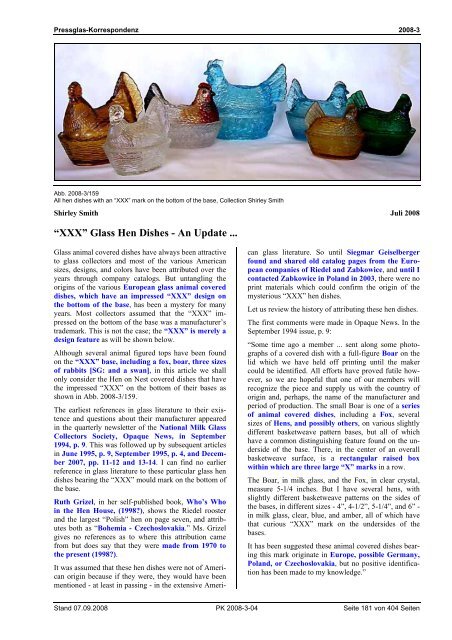
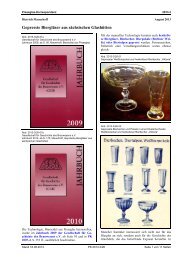
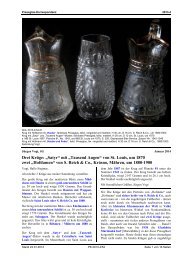
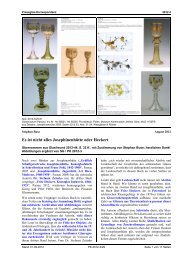
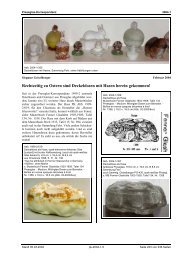
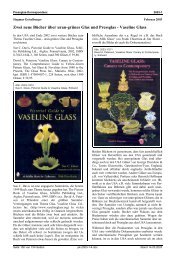

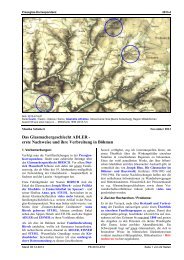
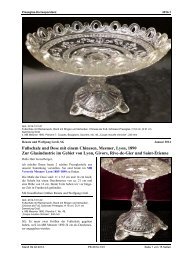
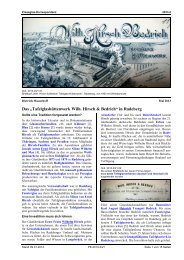
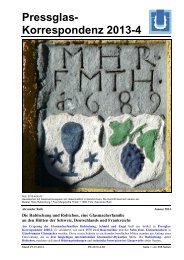
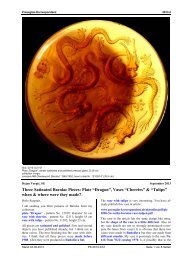
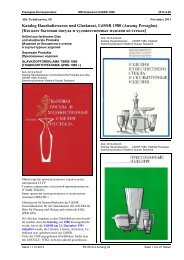
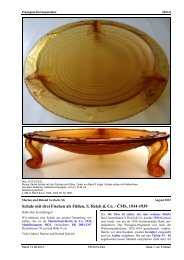

![Kapusta, Glasmachen im Bergland [Sklárstvà na horácku]](https://img.yumpu.com/25481954/1/184x260/kapusta-glasmachen-im-bergland-sklarstva-na-horacku.jpg?quality=85)